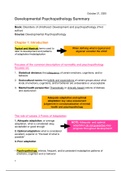October 21, 2020
Developmental Psychopathology Summary
Book: Disorders of childhood: Development and psychopathology (Third
edition)
Course: Developmental Psychopathology
Chapter 1: Introduction
Typical and Atypical: terms used to When defining what is typical and
refer to development and patterns atypical: consider the child/
of adaptation/maladaptation
Focuses of the common description of normality and psychopathology
focuses on:
1. Statistical deviance: the infrequency of certain emotions, cognitions, and/or
behavior
2. Sociocultural norms: the beliefs and expectations of certain groups about what
kinds of emotions, cognitions, and/or behavior are undesirable or unacceptable
3. Mental health perspective: Theoretically or clinically based notions of distress
and dysfunction
Adequate adaptation and optimal
adaptation: key value assessment
judgement in conceptualization of mental
health and psychopathology
The role of values: 3 Forms of Adaptation
1. Adequate adaptation: or average
NOTE: Adequate and optimal
adaptation, what is considered okay,
acceptable or good enough adaptation do not guarantee easy
progress throughout development!
2. Optimal adaptation: what is considered
excellent, superior or “the best of what is
possible”
3. Poor adaptation
• Psychopathology: intense, frequent, and/or persistent maladaptive patterns of
emotions, cognition and or behavior
1
, October 21, 2020
• Developmental psychopathology: It emphasizes that these maladaptive patterns
occur in the context of typical development and results in the current and
potential impairment of infants, children and adolescents
Estimate rates of disorders include:
1. Identifying children with clinically significant distress and dysfunction whether or
not they are in treatment
2. Calculating levels of general and specific psychopathologies and the
impairments associates with various disorders
3. Tracking changing trends in the identification and diagnosis of specific
categories of disorder
Developmental epidemiology: frequencies and patterns of distributions of
disorders in infants, children and adolescents
Prevalence and incidence
Measures of frequency of psychopathology
- Prevalence: the proportion of a population with a disorder (all current cases)
- Incidence: the rate at which new cases arise (all new cases in a given time
period)
Barriers to care Factors that impede access to mental health services,
including structural barriers such as lack of provider
availability, inconveniently located services,
transportation difficulties, inability to pay,
inadequate insurance coverage, or both; individual
barriers such as denial of problems or lack of trust in the
system; and sociocultural barriers such as the stigma of
1. Structural barriers: limited policy perspectives, disjointed systems, lack of
providers availability, long waiting lists, inconveniently located services,
transportation difficulties, and inability to pay and/or inadequate insurance coverage
2. Barriers related to perceptions about mental health: inability to acknowledge
a disorder, denial of problem severity, and belief that difficulties will resolve without
treatment
2
, October 21, 2020
3. Barriers related to perceptions about mental health services: Lack of trust in
the system, previous negative experiences, stigma
Stigmatization: Negative attitudes (such as blaming or overconcern with
dangerousness), emotions (such as shame, fear, or pity), and behaviors (such
as ridicule or isolation) related to psychopathology and mental illness.
Dimensions of stigma:
- Negative stereotypes
- Devaluation
- Discrimination
Targets of stigma:
- The individual
- The family
The contexts of stigma:
- The general public
- The self/individual
Developmental issues
Major developmental issues
Infancy Formation of an effective attachment
- Basis state and arousal regulation
- Development of reciprocity
- Dyadic regulation of emotion
Toddler period Guided self regulation
- increased autonomy
- increased awareness of self and others
- Awareness of standards for behavior
- Self conscious emotions
Preschool period Self regulation
- self reliance with support
- self management
- expanding social world
- internalization of rules and values
3
, October 21, 2020
School years Competence
- personal efficacy
- competence with peers
- self integration
- competence in school
Adolescence Individuation
- autonomy with connectedness
- identity
- peer network competence
- coordinating school, work, social life
Transition to Emancipation
adulthood - launching a life course
- financial responsibility
- adult social competence
- coordinating work, training, career, life
Behavioral indicators of abnormal behavior
• Developmental delay
• Developmental regression or deterioration
• Extremely high or low intensity and frequency of
The factors are various:
behavior
• Role of adults
• Behavioral difficulty persists over • Cultural norms
time • Gender norms
• Behavior inappropriate to the situation • Developmental norms
• Abrupt changes in behavior
• Several problem behaviors
• Behavior qualitatively different from normal
How common are problems?
Variability in rates due to:
- Different populations
- Different estimation methods
- Different definitions of psychopathology (measurements)
4




